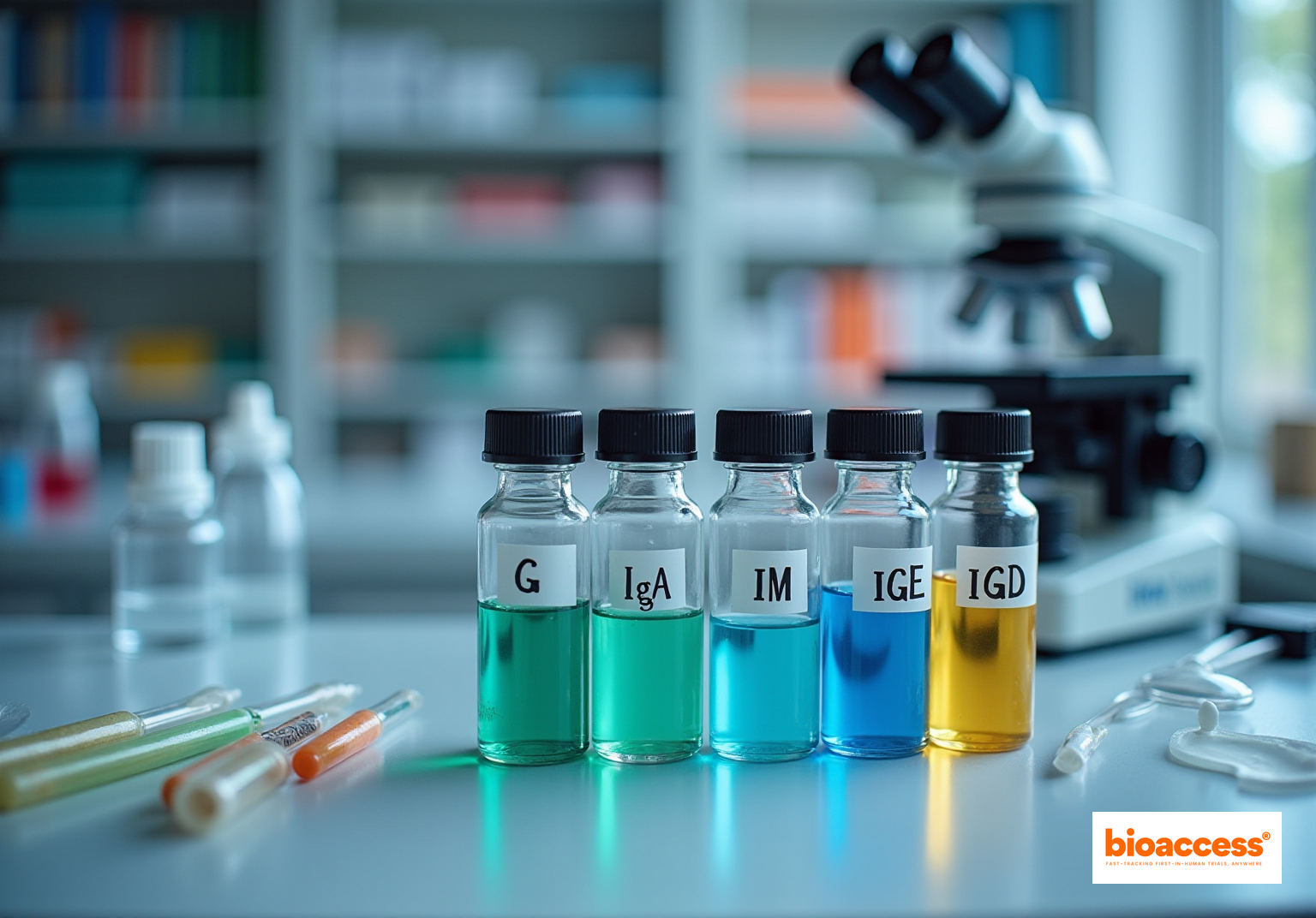


The article delves into the various isotypes of immunoglobulins—IgG, IgA, IgM, IgE, and IgD—and underscores their clinical relevance in immune response and disease management. Understanding these isotypes is paramount for the development of targeted therapies and diagnostics. Each isotype plays a distinct role in the immune system and can significantly influence patient outcomes in conditions such as autoimmune diseases and allergies. This knowledge not only enhances clinical practice but also drives innovation in therapeutic strategies.
Understanding the intricate world of immunoglobulin isotypes is essential for comprehending the immune system's functions and its responses to threats. Each isotype—IgG, IgA, IgM, IgE, and IgD—serves a distinct role in immune defense, influencing everything from pathogen recognition to the body's reactions to allergens.
As researchers delve deeper into the clinical implications of these isotypes, critical questions emerge:
This exploration not only emphasizes the significance of immunoglobulin isotypes in health and disease but also highlights their potential to shape future therapeutic strategies.
Isotypes of immunoglobulins, or classes of immunoglobulins, represent distinct forms of these proteins characterized by variations in their heavy chain structure and function. In humans, the isotypes of immunoglobulins—IgG, IgA, IgM, IgE, and IgD—each serve unique functions in the body's defense, influencing how it recognizes and combats pathogens. Notably, IgG constitutes approximately 80% of total immunoglobulins in serum, playing a crucial role in long-term immunity and pathogen neutralization. In contrast, IgM primarily exists as a pentamer, enhancing its ability to attach to multiple antigens simultaneously, and is the first immunoglobulin produced during an immune response, accounting for about 10% of serum immunoglobulins.
The significance of the isotypes of immunoglobulins extends beyond fundamental immunology; they are essential for developing targeted therapies and diagnostics in clinical settings. For example, IgA is vital for mucosal immunity, preventing pathogens from adhering to mucosal surfaces, while IgE, despite comprising only 0.002% of serum immunoglobulins, triggers the release of histamine and other substances from mast cells and basophils, playing a pivotal role in allergic reactions and responses to parasitic infections. Recent studies have highlighted the prevalence of specific isotypes in various autoimmune diseases, indicating that the presence of autoreactive proteins is a hallmark of these conditions.
Understanding the distinct functions and clinical relevance of isotypes of immunoglobulins is critical for advancing therapeutic strategies and enhancing patient outcomes. As research continues to uncover the complexities of these protein classes, their roles in response metrics and clinical applications will become increasingly significant in the realms of Medtech, Biopharma, and Radiopharma.
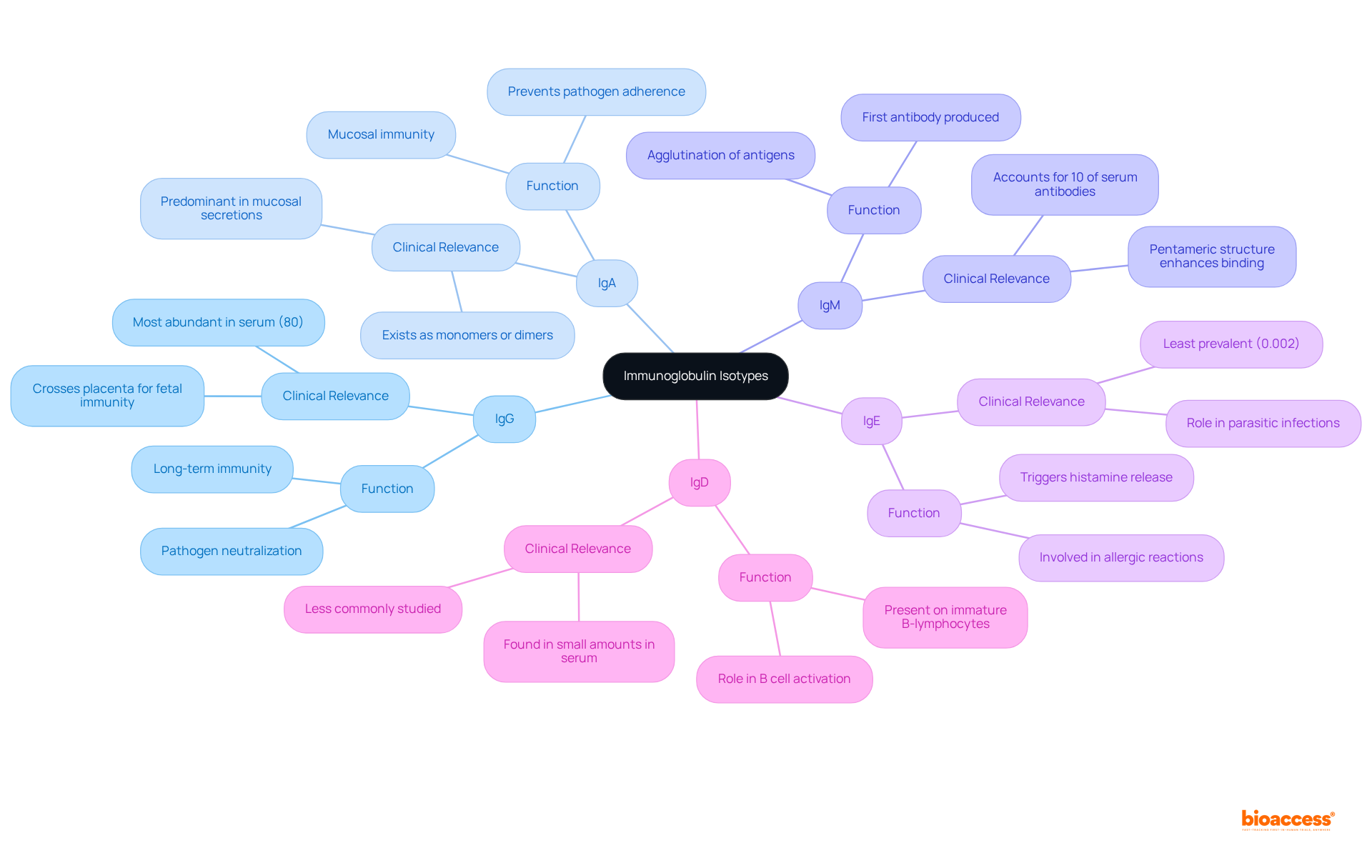
IgG: As the most prevalent immunoglobulin in serum, IgG plays a vital role in defense through opsonization, neutralization of toxins, and complement system activation. The isotypes of immunoglobulins include four subclasses—IgG1, IgG2, IgG3, and IgG4—each exhibiting unique functional properties. Elevated serum IgG levels are often associated with various autoimmune diseases, underscoring its diagnostic relevance. Significantly, IgG is found in blood at approximately 10 to 15 times the level of IgM and is the sole immunoglobulin class capable of traversing the placenta, offering protection to the developing fetus. The recommended reference range for serum IgG is 7.0-16.0 g/L.
IgA: Predominantly located in mucosal areas such as the gastrointestinal and respiratory tracts, IgA is essential for mucosal immunity. It exists in two forms: monomeric IgA in serum and dimeric IgA in secretions, such as saliva and breast milk. Its presence in these areas highlights its importance in protecting against pathogens entering through mucosal surfaces. Notably, serum IgA levels were significantly decreased in Crohn's disease (CD) patients in remission and those with mild-to-moderate disease compared to patients with severe disease. The recommended reference range for serum IgA is 0.7-4.0 g/L.
IgM: As the initial antibody generated during an immunological reaction, IgM is effective in forming antigen-antibody complexes and activating the complement system. Primarily found in the bloodstream, it serves as an early marker of infection, making it clinically significant in diagnosing acute infections. IgM possesses 10 antigen-binding sites when secreted as a pentamer molecule, enhancing its capacity to agglutinate pathogens. The recommended reference range for serum IgM is 0.4-2.3 g/L.
IgE: This is one of the isotypes of immunoglobulins that is primarily involved in allergic reactions and defense against parasitic infections. IgE binds to allergens and triggers histamine release from mast cells and basophils, leading to allergic symptoms. Its measurement is crucial in diagnosing allergic conditions and tracking treatment outcomes.
IgD: Although its precise function remains less understood, IgD is one of the isotypes of immunoglobulins that is mainly found on the surface of B cells, where it plays a role in initiating B cell activation and differentiation. Its clinical importance is still under investigation, but it is thought to aid in the regulation of bodily defenses.
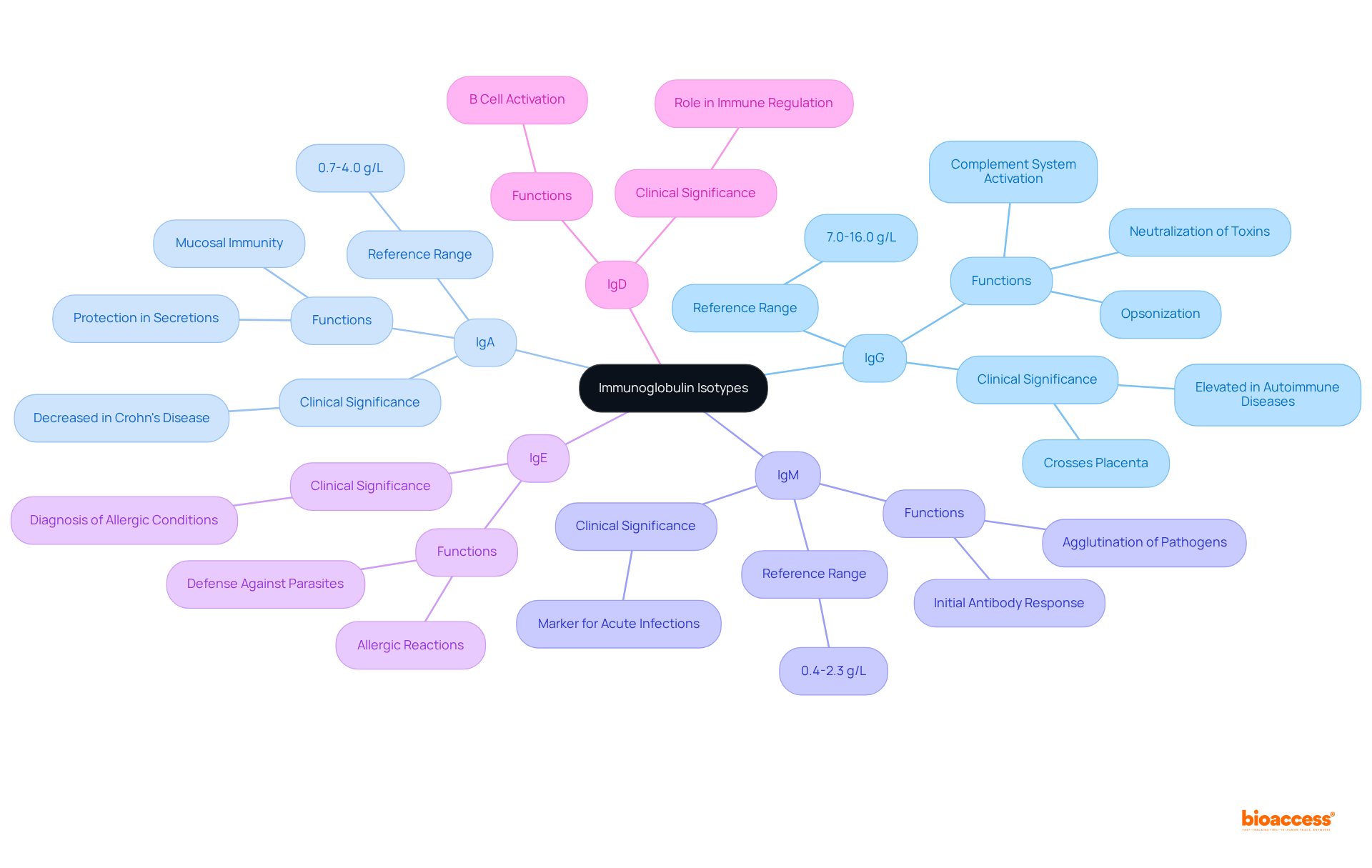
Class switching, also known as isotype switching, represents a vital biological process that enables B cells to alter the type of immune protein they produce while retaining specificity for the antigen. Initially, during the primary defense mechanism, B cells generate IgM immunoglobulins, which are the first isotypes of immunoglobulins formed before class switching occurs. However, upon receiving signals from T helper cells and various cytokines, these cells can transition to producing different isotypes of immunoglobulins, including IgG, IgA, or IgE proteins, tailored to address the specific biological challenge they face. This remarkable adaptability significantly enhances the effectiveness of the body's defenses, facilitating a more targeted and vigorous response against diverse pathogens.
Recent studies underscore the pivotal role of activation-induced cytidine deaminase (AID) in initiating class switch recombination (CSR), which is essential for this process. For instance, the interaction between AID and transcription factors such as ETS1 and PAX5 has been shown to bolster immune responses, aiding the shift from IgM to other isotypes. Janet Stavnezer articulates that the isotypes of immunoglobulins undergo class switching rapidly after the activation of mature naive B cells, resulting in a switch from the expression of IgM and IgD to the expression of IgG, IgE, or IgA. This adaptability not only enhances the quality of the body's immune response but also carries implications for the development of immunotherapies and vaccines, as the type of protein produced can influence the overall efficacy of the body's reaction. Furthermore, a comprehensive understanding of class switching is crucial for advancing therapeutic strategies aimed at strengthening immune function, given that CSR dysregulation can lead to autoimmune diseases, including rheumatoid arthritis.
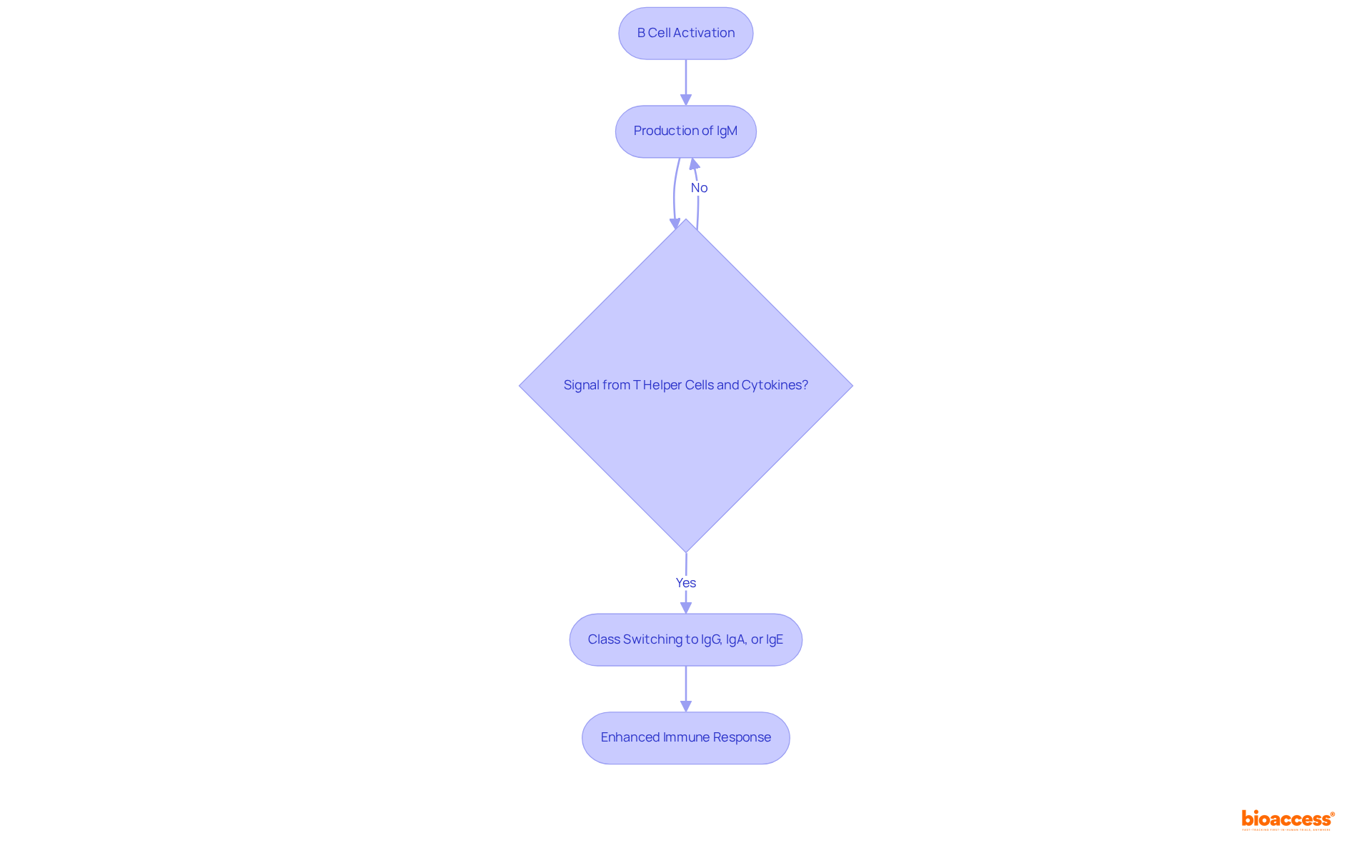
The isotypes of immunoglobulins are pivotal in clinical applications, particularly in diagnostics and therapeutics. Measuring specific isotype levels significantly aids in diagnosing immunological disorders, including allergies and autoimmune diseases.
For instance, intravenous immunoglobulin (IVIG) therapy, primarily utilizing IgG—representing 70-85% of the total immunoglobulin pool—has proven effective in treating conditions such as immunodeficiencies and various autoimmune disorders. Recent studies indicate that IVIG therapy can enhance patient outcomes, evidenced by a notable reduction in infection rates and improved quality of life for those with secondary immunodeficiencies.
Furthermore, current research is exploring the therapeutic potential of various isotypes, particularly how isotype selection can enhance the effectiveness of monoclonal agents in cancer therapy. A case in point is the glycoengineered anti-CD20 antibody obinutuzumab, which has demonstrated nearly double the progression-free survival in chronic lymphocytic leukemia patients compared to rituximab.
Understanding the distinct roles of the isotypes of immunoglobulins is essential for developing targeted therapies and personalized medicine approaches, ultimately leading to more effective treatments and better patient outcomes. It is also crucial to consider the potential adverse effects of IVIG therapy, which can include renal toxicity and infusion-related reactions, ensuring a balanced view of its clinical applications.
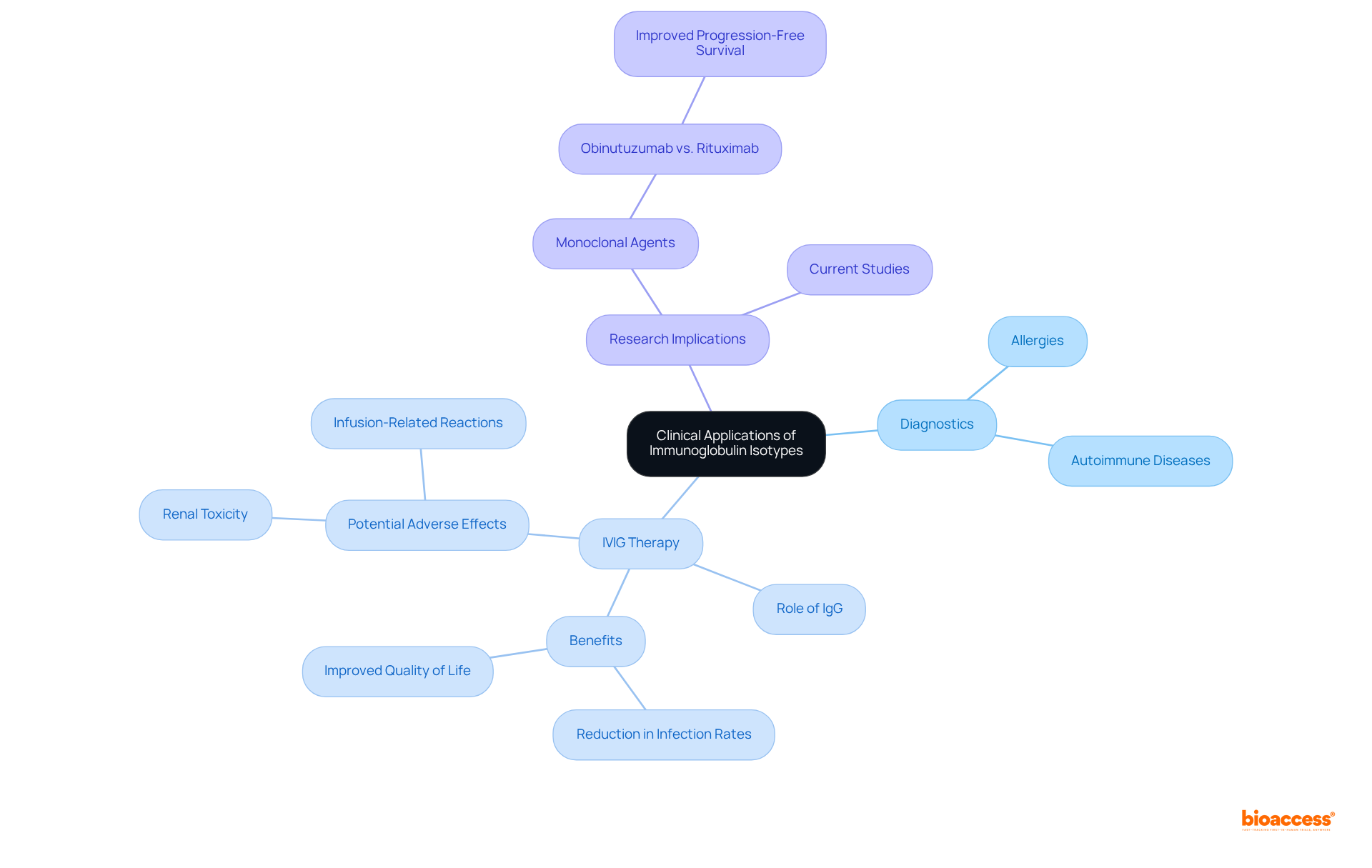
Understanding the various isotypes of immunoglobulins is essential for comprehending their multifaceted roles in the immune system and clinical applications. Each isotype—IgG, IgA, IgM, IgE, and IgD—serves distinct functions vital for the body’s defense mechanisms against pathogens. Their unique structures and properties not only influence immune responses but also have significant implications for diagnostics and therapeutic strategies in medicine.
The importance of each immunoglobulin isotype is underscored, showcasing specific functions such as:
The process of class switching is also discussed, emphasizing how B cells adapt their immunological responses to effectively combat diverse challenges. This adaptability is pivotal for developing targeted therapies and personalized medicine approaches, which can lead to improved patient outcomes.
In conclusion, the exploration of immunoglobulin isotypes highlights their critical role in health and disease, revealing a landscape rich with potential for future research and clinical advancements. As ongoing studies continue to unravel the complexities of these proteins, it becomes increasingly essential for healthcare professionals and researchers to harness this knowledge, paving the way for innovative treatments and enhanced understanding of immune-related conditions. The significance of immunoglobulin isotypes in clinical practice cannot be overstated, making it imperative to stay informed about the latest developments in this field.
What are immunoglobulin isotypes?
Immunoglobulin isotypes are distinct forms of immunoglobulins characterized by variations in their heavy chain structure and function. In humans, the main isotypes are IgG, IgA, IgM, IgE, and IgD.
What is the role of IgG in the immune system?
IgG constitutes approximately 80% of total immunoglobulins in serum and plays a crucial role in long-term immunity and pathogen neutralization.
How does IgM function in the immune response?
IgM primarily exists as a pentamer, allowing it to attach to multiple antigens simultaneously. It is the first immunoglobulin produced during an immune response and accounts for about 10% of serum immunoglobulins.
Why is IgA important for mucosal immunity?
IgA is vital for mucosal immunity as it prevents pathogens from adhering to mucosal surfaces, thereby helping to protect these areas from infections.
What is the significance of IgE in the immune system?
IgE, despite comprising only 0.002% of serum immunoglobulins, triggers the release of histamine and other substances from mast cells and basophils, playing a pivotal role in allergic reactions and responses to parasitic infections.
How do immunoglobulin isotypes relate to autoimmune diseases?
Recent studies have shown that specific isotypes of immunoglobulins are prevalent in various autoimmune diseases, indicating that the presence of autoreactive proteins is a hallmark of these conditions.
Why is understanding immunoglobulin isotypes important for clinical applications?
Understanding the distinct functions and clinical relevance of immunoglobulin isotypes is critical for developing targeted therapies and diagnostics, which can enhance patient outcomes in fields like Medtech, Biopharma, and Radiopharma.